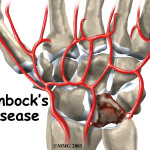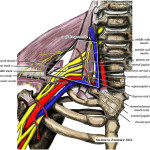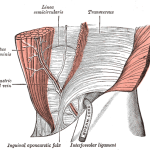Osteitis Pubis is a condition that many consider rare, however, it is probably more common than you may think. The incidence of groin pain, in some sports, is as high as 13% (Ekstrand and Ringbord, 2001). Thus, it is highly likely that as a sports physiotherapist you will encounter may athletes with a diagnosis of osteitis pubis. Therefore, as is frequently stated on this site, you need to be aware of the current research and evidence based practice, even in a world with limited research.
OVERVIEW
Osteitis pubis is defined as a painful inflammatory process involving the pubic symphysis and surrounding structures including the pubic rami, cartilage, musculotendinous and ligamentous pelvic structures (Batt et al, 1995). It is suggested that this is caused by repetitive stresses of the pubic symphysis during strenuous physical activity, most commonly secondary to reduced hip range of motion (LeBlanc and LeBlanc, 2003).
DIAGNOSIS
Subjective:
- CHx: The athlete will often report an insidious onset of groin pain, with nil major traumatic incident.
- Pain: Will usually be present in the groin and lower abdominal region.
- Agg: Aggravating activities will likely include running, stepping, jumping and kicking.
Objective:
- AROM: generally reduced hip range of motion, particularly abduction and rotations
- RIMT: adduction and lower abdominal activation will reproduce pain
- Palp: there will be tenderness around the groin and lower abdominal musculature with marked tenderness on palpation of the pubic symphysis.
NB: A cornerstone of successful conservative osteitis pubis treatment will be addressing biomechanical and functional deviations at both the hip and lumbosacral complex, therefore these regions should be appropriately assessed and treated (Wollin and Lovell, 2006). This is further discussed below.
DDx: Some important and common competing hypotheses are listed below (Choi et al, 2011):
- Strain
- Sportsman’s Hernia
- Stress #
- Hip Pathology (FAI)
- LBP Referral
RADIOGRAPHY
X-Ray: normal radiographic findings may include:
- loss of the smooth cortical periphery
- reactive sclerosis
- rarefaction
- superficial bone destruction with occasional heterotopic ossification
- greater than 10-mm separation of the symphysis
- symphyseal instability as demonstrated by movement of the symphysis of more than 2 mm on step films (Lentz, 1995)
Bone Scan: has greater sensitivity than plain film X-ray.
MRI/CT: Also diagnostic of osteitis pubis. Also particularly useful in exclusion of competing hypotheses.
TREATMENT
The following discussion regarding treatment decisions is guided by the systematic review by Choi et al (2011). Whilst they searched for the best available evidence, they were unable to identify any RCTs regarding treatment decisions for osteitis pubis. Therefore, the following recommendations are based on clinical experience and case studies/series. Hint, hint… not a lot of rock solid evidence going around.
CONSERVATIVE MANAGEMENT
This generally involves the three mainstays of an inflammatory musculoskeletal condition: relative rest, NSAIDs, and physiotherapy!
Physiotherapy treatment, as always, should be based on the individual athlete and their assessment findings. Thus, as stated above, you should assess for biomechanical and functional impairments and treat accordingly. The components of a successful conservative rehabilitation program included (Wollin and Lovell, 2006):
- Manual techniques to restore full range of motion in the lumbar, sacral and hip joints. This included soft tissue, MET, mobilisation and manipulative techniques.
- Core Control Exercises (TrA and Pelvic Floor Training)
- Adductor Strengthening (Progression of gentle isometric through to loaded isotonic strengthening)
- Gluteal Strengthening
- PNF patterns
- Stationary Bike
- Return to running program
- Graduated and progressive return to play
Whilst this is by no means a recipe for your patients, it should serve as an indicator of the components of a successful rehabilitation program. In this small case series (n=4) all players returned to play at a mean time of 13 weeks.
The results of this study mirrored the overall findings of Choi et al (2011) who found that the mean return to play for all patients undergoing conservative management was 9.55 weeks! Not bad…
INJECTIONAL THERAPY
The studies examined two types of injectional therapy corticosteroid or prolotherapy.
- Corticosteroid Injections: Overall 58.6% of patients RTP in 8 weeks, whilst there was no response in approximately 20% of patients.
- Prolotherapy Injections: Topol et al (2005) examined prolotherapy injections in patients with chronic groin pain and found much more promising than the corticosteroid injections! 91.7% of the athletes RTP in 9 weeks, and there was a 8.3% no response rate. Be warned, I have been told it hurts…a lot.
SURGICAL MANAGEMENT
As you may expect surgical management should only be considered as a last resort. Dependant on the choice of surgery, which is widely variable in clinical practice, it can be a season ending operation. Therefore, it is not a decision to make lightly. The case series literature describes three surgical techniques (Choi et al, 2011). These are discussed below:
- Curettage of Pubic Symphysis: 72% RTP at an average of 5.6 months
- Arthrodesis of the Pubic Symphysis: 87% RTP at an average of 6.6 months, with a 25% complication rate.
- Polypropylene Mesh Placement into the Preperitoneal Retropubic Space: 92.3% RTP at an average of 7.2 weeks.
TAKE HOME MESSAGES
- There is a dearth of quality research to guide treatment decisions for osteitis pubis.
- Conservative management should always be the first line of treatment for osteitis pubis.
- Optimal management is individualised and always looks “beyond the groin”!
- Prolotherapy could be used if physiotherapy fails (but it hurts!).
- Surgery is a last resort only!
What are your experiences in the treatment of osteitis pubis. It can be a fiddly and tricky condition! Hit me up in the comments or catch me on Facebook or Twitter
If you require any sports physiotherapy products be sure check out PhysioSupplies (AUS) or MedEx Supply (Worldwide)
REFERENCES
Batt ME, McShane JM, Dillingham MF. Osteitis pubis in collegiate football players. Med Sci Sports Exerc 1995;27:629–33.
Choi H, McCartney M, Best TM. Treatment of osteitis pubis and osteomyelitis of the pubic symphysis in athletes: a systematic review. Br J Sports Med 2011 45: 57-64
Ekstrand J, Ringborg S. Surgery versus conservative treatment in soccer players with chronic groin pain: a prospective randomised study in soccer players. Eur J Sports Traumatol 2001;23:141–5.
LeBlanc KE, LeBlanc KA. Groin pain in athletes. Hernia 2003;7:68–7
Lentz, Samuel S. Osteitis Pubis: A Review. Obstetrical & Gynecological Survey 1995;50(4):310-315
Topol GA, Reeves KD, Hassanein KM. Efficacy of dextrose prolotherapy in elite male kicking-sport athletes with chronic groin pain. Arch Phys Med Rehabil 2005;86:697–702.
Wollin M, Lovell G. Osteitis pubis in four young football players: a case series demonstrating successful rehabilitation. Phys Ther Sport 2006;7:153–60
Related Posts
Comments










I was diagnosed with this condition, however I am not an athlete. I did however, give birth to a 9.9 baby and during the delivery he came out with force. this was thoufht to cause the injury. by the time the child was a year old i could barly walk and spurs had developed in my groin, in addition, you could hear a loud clicking noise in my groin. It took months to diagnose, however, after doing physical therapy, the pain compely went away.
I,ve had this painful condition for nearly 5yrs now.I was told by three surgeons i needed a hip replacement which i was skeptical about.I was eventually diagnosed after a bone scan and MRI.I now have regular steroid injections into the pubic bone.As a nurse i,m lucky that i work with consultants that do this all for me.It is very frustrating when i,m having a hard time with the pain as no-one knows this condition.I see a great osteopath regulary which helps but really dont know how much longer i,ll have it for[It rules my life as i cant walk distances etc and i have young children.
I too was diagnosed with this condition after giving birth to two babies 14 months apart. Even before having children I was never able to ride a bike due to extreme groin pain. I had an X-ray of my pelvis done a couple of years before having kids and the ortho blew me off and never gave it name but rather said ‘it’s something athletes get’. Funny thing is, I’m not at athlete! I did dance in high school and was always freakishly limber in my younger years. An MRI finally diagnosed (moderate to severe OP) this condition after my second child and I’ve done years of physical therapy but unfortunately still have groin pain and an unstable pelvis. I’m going for a neurosurgery consult and updated MRI’s this week (it’s been 3 years). I also have a herniated disk at my L5-S1 that refuses to heal and arthritis in my L3, L4 and L5 . After numerous steroid injections in my facets and SI Joints with limited success I’m considering surgery. I’d love to hear from anyone who may have experienced anything similar to what I’ve been experiencing!
Amber,
I have been going to nmerous doctors over the past year and still don’t have a definitive dx. I have had a wedge resection of the pubic symphysis, steroid injection there, 6 MRI’s, steroid injection into the hip labrum, PT with several modalities, home exercises. I also have a herniated disk at L5-S1 with no pain there. My latest dx is tendenosis of the adductor longus. I have a hx of tendenosis in my writs. After a great deal of reading online, I found info about collagen (Level 1, Level III imbalance) I also have osteoporosis. These 3 condtions are characteristic of that imbalance! My sister has also suffered with numerous tendon issues. It IS congenital! I’m going to share this with my PT andsee her response. Then my Orthoedist. I’m tired of the pain and limited mobiility!
Can anyone recommend a good Physio in Melbourne that deals with oteo pubis.